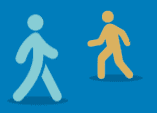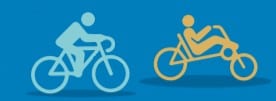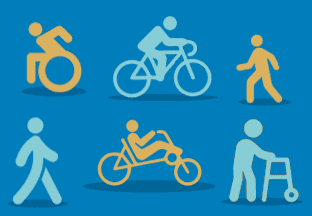Introduction
Active travel involves a wide range of mobilities which Wheels for Wellbeing describe as walking, wheeling and cycling. These are our definitions.
Walking:
Foot/pedestrian-based mobility that may incorporate the support of aids to mobility such as stick/s, cane/s, crutch/es, the arm of another person and/or assistance animal/s.

Wheeling:
An equivalent alternative to foot/pedestrian-based mobility. Includes wheeled mobilities such as manual self- or assistant-propelled wheelchairs, including wheelchairs with power attachments or all-terrain attachments (such as the “Freewheel”), powered wheelchairs, mobility scooters (three and four-wheeled) and rollators. Some people rely on their cycle to move (at a pedestrian’s pace) through pedestrianised environments when it is not physically possible to walk/push their cycle. Some people use their cycle as a walking aid, by leaning on it, some people use e-scooters (with or without a seat), to wheel/scoot through pedestrianised environment if they cannot walk unaided.
We recommend never using “walking” on its own as it potentially reinforces ableist stereotypes and makes Disabled people invisible. Instead, we recommend always using “walking, wheeling” together. Both words represent the action of moving at a pedestrian’s pace, whether or not someone is standing or sitting, walking or wheeling unaided or using any kind of aid to mobility, including walking aids, wheeled aids, personal assistants or support animals.

Cycling:
Incorporates the action of moving (at speed) on a wide range of pedal-powered wheeled transport that may be powered with hands and/or feet, may transport one or more persons, may or may not include e-assist, and may have from 2 to 4 wheels.

Downloads:
Walking, wheeling and cycling definitions in docx format
Walking, wheeling and cycling definitions in pdf format

